‘We are all being encouraged now to tap into the kinder part of our character, to eat more compassionately, both for animals and the planet. I feel there’s a deeper, more spiritual side to this way of eating that I’m beginning to explore more every day,’ says Taiwanese TV chef and author Ching-He Huang, who is known for her regular appearances on shows such as Saturday Kitchen and hugely successful books, including Wok On and Ching’s Chinese Food in Minutes. Ching’s latest book, Asian Green (Kyle Books, £20, published 21 January 2021), celebrates plant-based cooking
‘I was vegan when I was aged 13-14 for about a year, when I met my Buddhist master in Taiwan,’ says Ching. ‘Both my parents are plant-based because they are Buddhists and my husband went plant-based about eight years ago, and it has cured his asthma, which he’s had since he was a baby, so we eat mostly vegan at home now. My take on Asian cuisine is a very flexible way of eating anyway, the dishes are designed to be adaptable. I’m not here to preach to people or tell them how to eat, I’m just here to share my own journey and how positive it has been for my family.’
Enthused about plant-based eating and an expert at cooking with tofu, Ching has teamed up with Cauldron Foods to encourage everyone to give tofu a try – or perhaps a second chance. ‘It’s such a fantastic, under-rated ingredient, it’s low in saturated fat and it’s so good for you,’ she says. ‘It keeps for ages, and it’s a really sustainable product. Yes, the rainforest is being cut down to grow soya, but 80% of soya grown in the Amazon is for animal feed, only 6% of soya produced globally is used for human consumption. If we all ate more tofu instead of meat we could feed 3.5 billion more people.
‘The humble soya bean has been sustaining China and most of Asia for centuries, without it we would be lost. It’s a complete protein, it can also be used to make soya sauce, miso, all kinds of sauces, not just beancurd. Not to mention fresh edamame beans!’
Ching recognizes that many people worry about how to cook tofu, concerned that it might taste bland, and the fact that it doesn’t always look very appetizing in its raw state, swimming in a little pack of water. ‘I always say to my students, “do you know how to make couscous?” and they always say yes,’ says Ching. ‘Well I say if you know how to cook couscous then you can cook tofu, as making couscous is much harder to get right. It’s like tofu in that you have to cook it, but it’s quite bland so you have to add flavour into it. Tofu comes out of the pack and people say they don’t know what to do with it, but I always say it’s all about the sauces and the flavour you inject into it. It’s a dark horse as an ingredient. There are so many exciting things you can do with it. You can cook it in a braise, shallow fry to make it crispy, roast it in the oven. It’s definitely a lot more versatile than couscous! You can even make desserts with it.’
If you’re new to tofu, Ching suggests starting with a classic recipe that everyone loves. ‘Something like a Thai green curry is great, because you can just let the tofu absorb the flavours of the sauce. Or roasting it is such a simple way to cook it. Cut it into nice chunky pieces and add vegetables such as tenderstem broccoli, peppers, tomatoes and cover in a teriyaki-style marinade and a drizzle of oil, then pop it in the oven. So easy and delicious.’
A stir fry is a classic way to enjoy tofu, and Ching recommends frying it first to get a crisp exterior, then stir frying your vegetables until al dente, stirring through your cooked noodles, and finally adding the tofu back into the dish at the end. ‘I like to wok or pan fry tofu in a little oil with some aromatics such as garlic, ginger and chilli and some soy sauce, and a dash of dark soy for colour.
‘One of my favourite simple dishes is tofu stir fried with garlic, sesame oil, ground white pepper, edamame beans, soy sauce and a scattering of fresh coriander at the end. Everyone loves this and it’s so straightforward.’
So, bold flavours are key when it comes to bringing out the best in tofu? ‘I think the biggest mistake people make is not injecting enough flavour,’ she agrees. ‘You can use Chinese five spice, mushroom sauce, turmeric, anything you like. My secret ingredient is cornflour – adding a dusting of cornflour helps sticks the spices onto the tofu and allows the flavours to give it a lovely hug!’
The big question is, to press or not to press? ‘I like to press tofu, but it depends on the recipe,’ she says. ‘Definitely press if you’re frying the tofu and want a nice crisp golden crust or if it’s going in a dry stir fry. But if you don’t have time then a pat with kitchen towel will suffice!’
Ching’s enthusiasm for plant-based food is infectious, and her recipes manage to combine authenticity with accessibility. ‘My ethos is all about helping people to make delicious food at home, and also to share my culture as well as my best tips for getting great results in the kitchen,’ she says.
‘I believe that when you learn how to cook, you are showing yourself love, and when you cook for other people you are sharing your love with them. The next step is learning to cook compassionately; it’s an expression of love for people, animals and the planet.’
Ching’s top tofu tips:
Do not add oil when marinating your tofu
Adding oil to your marinade will prevent it from seeping into the tofu and ultimately acts as a barrier. A handy tip is to oil your pan instead of the tofu, if you want to achieve really flavoursome tofu
Drain the tofu water bath and press out excess liquid
Not draining and pressing your tofu to remove excess moisture will result in you making a ‘wet stir fry’. If you you’re making a ‘dry-fry’ dish, before you do anything with your tofu, press it for around 10-20 minutes by placing it between two chopping boards lined with kitchen roll and putting something heavy on top to apply pressure.
Do not over stir your tofu dish
This is a common mistake. Over stirring will result in your tofu breaking down, which means you will end up with a scrambled dish as opposed to lovely chunky shapes.
Store your tofu correctly
Not storing your tofu in clean water will reduce the shelf life, leading to the tofu turning bad quickly and tasting sour. Cover any leftover unprepared tofu in filtered water and pop in the fridge, as this will keep it in good shape for a few days.
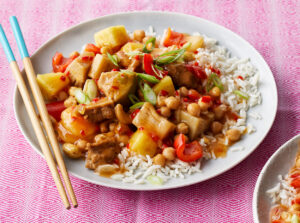
Sweet & sour 2.0 – jackfruit, seitan, pineapple, peppers & chickpeas
A Chinese takeaway classic reinvented with a fresh, fruity-spicy sauce and the satisfying textures of seitan and jackfruit.
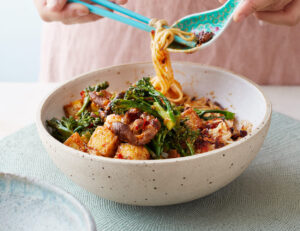
Smoked tofu & broccoli Korean-style ram-don
A vegan take on a traditional Korean ram-don, this umami-rich noodle dish with tofu and broccoli is moreish and addictively spicy.
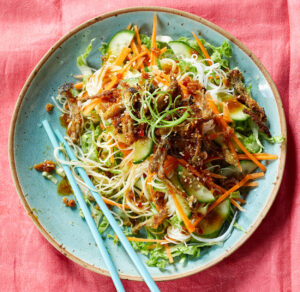
Hunan-style crispy sweet chilli mushroom & noodle salad
Combine a raw vegetable noodle salad with crispy oven-baked mushrooms and a sweet-and spicy sauce for a light dish packed with flavour and texture.
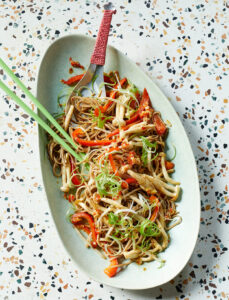
Five spice mixed mushroom soba chow mein
This deliciously easy takeaway favourite combines buckwheat noodles with a ginger, mushroom and Chinese five-spice sauce.
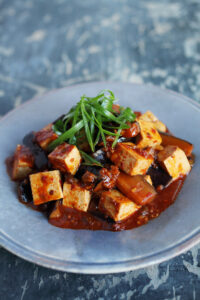
Spicy Sichuan-style aubergine and tofu
Packed with rich, spicy flavours, serve this quick and easy aubergine dish with Jasmine rice for a tasty midweek feast.
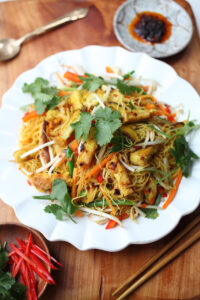
Golden tofu Singapore noodles
Turmeric-spiced crispy golden tofu with noodles, aromatic vegetables and a kick of red chilli make this classic dish far tastier than anything from the takeaway.

